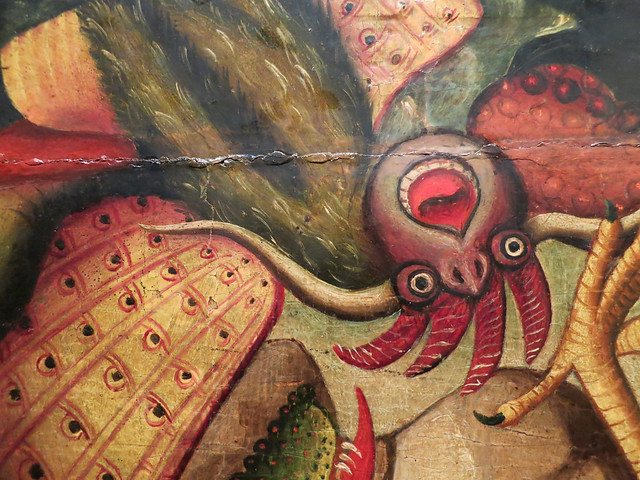 |
| Miguel Ximénez, 1466-1505, God the Father and Saints Crushing Demons c. 1490 |
I recently agreed -- breaking my great period of NO -- to write a book chapter on animals and disability simply because it's been a paper I've long wished I'd written, and because I can see this work fitting into my long percolating, almost mythical second book project. When prodded, here's what I pitched:
For several years I've wanted to write an essay on the way that 'mute beasts' communicate through gesture in a host of medieval texts (famous examples include the ravens in Bede's Life of Cuthbert and the lion in Yvain), with some consideration of the way that some monks complained that the use of monastic sign language reduced them to animality. So, a chapter on disability and animals, in terms of muteness, interspecies communication, sign language, and signs, maybe with a strong gesture towards the use of CS Peirce in HOW FORESTS THINK, would be a lot of fun to write.As of yesterday, inspired by conversations with an independent study student, I'm thinking I also need (at least) a section on DEMONS. Why? Because one key symptom of demonic possession is altered speech: the possessed person often can only howl like an animal, or -- by the thirteenth century -- speaks all too fluently, with the undying reason of the demon, compelled by God or His earthly agents to preach the truth of salvation and holy history. The "mute beast" is anything but mute; the rational demon ("animal aereum, rationale, immortale, patibile, diligentiam hominibus impertiens" eg) is a machine for telling the truth. The one incomprehensible and constrained, the other perfectly, even excessively comprehensible, yet also, quite vividly, constrained. Obviously, given what will be a likely focus on later medieval demoniacs, gender (specially, the disturbance of publicly speaking women) will be a focus. Keywords: agency, voice, truth, authenticity, gender, and the body.
Here's the reading to date for a project that almost certainly cannot become be-worded until next Summer:
Blumenfeld-Kosinski, Renate. "The Strange Case of Ermine de Reims (c. 1347–1396): A Medieval Woman between Demons and Saints." Speculum 85.02 (2010): 321-356.
Craig, Leigh Ann. "The Spirit of Madness: Uncertainty, Diagnosis, and the Restoration of Sanity in the Miracles of Henry VI." Journal of Medieval Religious Cultures 39.1 (2013): 60-93.
Newman, Barbara. "Possessed by the spirit: Devout women, demoniacs, and the apostolic life in the thirteenth century." Speculum 73.03 (1998): 733-770
In the meantime, I have papers on oysters, fables, medieval race, materialism and gender to revise, write, co-write, and write, respectively. Some of these are not yet due.
So much here of interest: this will be a great project, especially in its confluence of animal studies and disability. The demonology part will be complicated because demons have such a lively presence in literature where they are not necessarily predetermined by theological discourse, and are not so much machines for the telling of truth as intermediaries for truth's distortion (they are equivocators rather than truth tellers). You'll find lots on demons and truth [not] telling in considerations of Merlin and other secular prophets, and the legends that cluster around the necromancer pope Sylvester (né Gilbert). Another great source for demoniac knowledge and limitations: the Friar's Tale, with its long explication of how sometimes demons have power over bodies and souls, sometimes one or the other (and when it is over the body, they can disable a person) -- as well as about demons' changing embodiments (sometimes they create bodies, sometimes they inhabit corpses). Anyway, the fiend in the Friar's tale is a great example of the equivocating type who uses words to trigger actions with embodied consequences.
ReplyDeleteThank YOU my busy friend.
ReplyDeleteI'll say that my interest in *constrained* demons has to do with an undercurrent of questioning of the phrase 'be reasonable' (going back to my first tangling with the 'Human Biological Diversity' racists). There's a way, for some thinkers, in which 'reason' is a constraint, because being reasonable means 'according with the facts' or 'telling the truth' (where the truth is just one thing). There's a way, then, in which reason becomes a way to tether someone or something to the truth, so it becomes less free the greater its accuracy.
So, YES, I know the sneaky demons, and the lying deceptive demons of, say, the desert saints (where they go in disguise), but I'm also interested in the way the rationality of demons becomes a way to constrain them.
And -- at any rate -- I'm just super surprised at the stories of thirteenth-century demoniac preachers that Newman tells: it was news to me, and I want to do something with them.